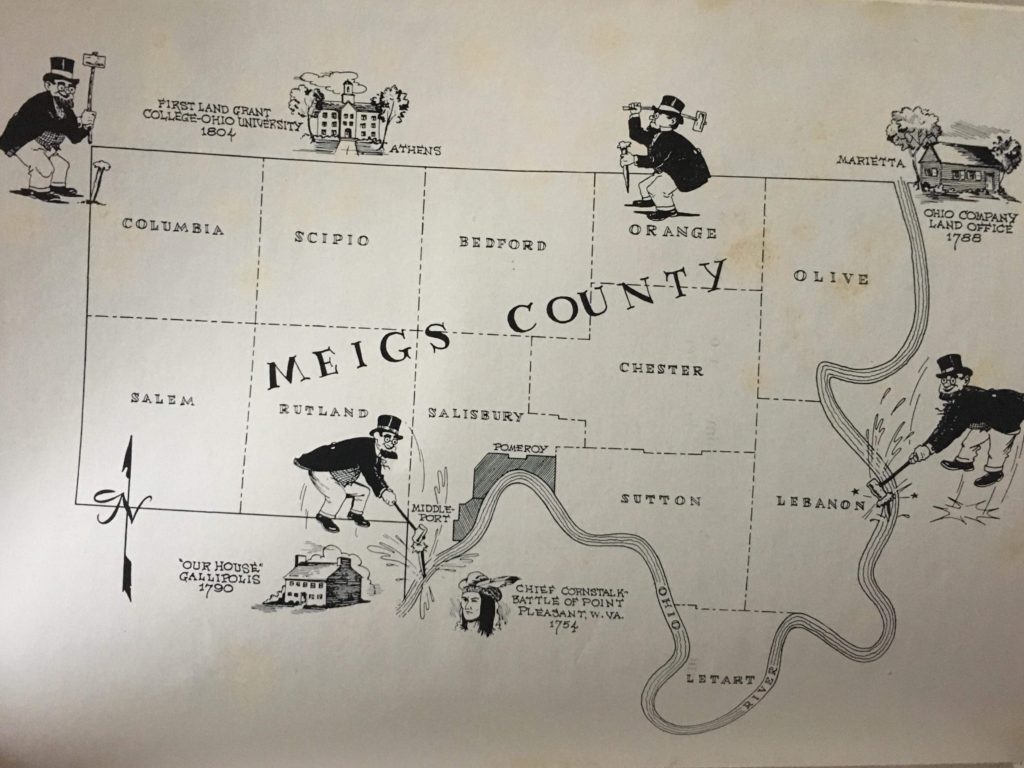History of Meigs County Townships, Part 1

Meigs County, Ohio townships

Meigs County was formed on April 1, 1819, and was created out of parts of Athens and Gallia Counties. Originally, Washington County included all of what would become Gallia, Athens, and Meigs Counties. Gallia County was organized in 1803, and Athens County was formed in 1805. Often overlooked is the interesting township history of these respective counties before the creation of Meigs County. This two-part article will give a brief history of each of Meigs County’s 12 townships. The first article will recall those originally part of Gallia County with the second evoking the townships that were part of Athens County. Interestingly enough, when Meigs County was formed in 1919, it was not formed with the 12 townships as they are today.
Letart Township was organized initially as one of the three townships that made up Gallia County in 1803, and by 1810 there were 501 living in the township. Letart Township’s original boundaries stretched from the mouth of the Shade River, following the Ohio River to Kerr’s Run, then North to the county line and returning East to meet the mouth of the Shade River; encompassing all of present day Sutton and Lebanon Townships, as well as parts of Orange and Olive Townships. According to Ervin’s Pioneer History of Meigs County, “Tradition has it that on the Falls at Letart the body of a Frenchman was found drowned in the Ohio River and on his arm was tattooed the name ‘Letart.’” Various history books and maps have reported this area Tart’s Falls, Le Tart, Let’ Art and Letartsville.
Salisbury Township was organized in 1805 as part of Gallia County, which in turn was originally part of Washington County in 1803. Part of the original Salisbury territory extended west to present-day Ross County. In the shifting of the of the territory early on in its history (1805), part of it was known as Kerr Township, named for Hamilton Kerr, one of the early settlers where Kerr’s Run is today. From there, in 1807 Salisbury Township was re-organized to its present boundaries, and from its old boundaries eventually came Rutland Township (1812) and Salem Township (1813). Salisbury Township is believed to have gotten its name from Salisbury, England in Wiltshire County. Salisbury, England was settled at the confluence of the rivers Avon, Nadder, Ebble, Wylye and Bourne. It’s believed, due to the similarities of confluences, Salisbury Township was laid out where Kerrs Run, Naylors Run, Sugar Run, Africa Run (now Monkey Run), Leading Creek, and Story’s Run all meet at the Ohio River.
Rutland Township was organized in 1812 and gets its name from Rutland, Massachusetts, the home of General Rufus Putnam. Rutland, Massachusetts was named in honor of the Duke of Rutland of England in 1686. When Rutland Township was originally surveyed, it was originally 36 square miles. When it was determined to organize Meigs County, it was feared that the area set aside would not meet the minimum number of square miles required (400 to 420 square miles) in each county. It was decided to take an additional row of 12 sections from Gallia County (6 from Morgan Township and 6 from Cheshire Township) to give to Meigs County (6 in Salem Township and 6 in Rutland Township) to meet the required number of square miles needed. These additional sections were added in April of 1819.
Lebanon Township was organized in 1813 and taken from Letart Township. Lebanon Township boasts the largest amount of Ohio River frontage with a total of 14.5 miles. The township earns the name Lebanon due to its dense forests at the time of its founding, and refers to biblical scripture. The cedar of Lebanon is mentioned seventy-seven times in the Bible.
According to Larkin’s Pioneer History of Meigs County,
It was a dense forest at the time of its organization. Trees of great size, and timber of the finest quality, covered the rich bottom lands of the Ohio River and the creeks of Old Town and Groundhog, while the hills bore the best yellow pine and spruce for lumber. The sugar maple, hickory, black oak and white oak, poplar, beech and sycamore excelled in size and quality any forests of Europe. The black walnut, white walnut and wild cherry were favorite woods for the manufacture of furniture, and for inside work of the best houses. Black walnut and cherry were used particularly for the making of coffins in those early days. So these trees of Lebanon had special attractions to the commercial eyes of later emigrants.
Salem Township, which originally included Wilkesville Township, now a part of Vinton County, was set off from Salisbury Township and organized in 1814. It is one of14 townships in the state of Ohio bearing the name Salem, which comes from Salem, Massachusetts, home to many of the members of the Ohio Company Purchase. The first settler of the eventual Salem Township was Captain James Merrill, a sea-faring man who commanded vessels owned by Timothy Dexter in the East India Trade. After years of service and growing weary of sea life, Dexter gave Merrill a farm and large tract of land from his share of the Ohio Company Purchase with the intention of having Merrill settle the land and take charge of the remainder. Merrill built the first frame house in what is now Meigs County. Merrill named Dexter Creek after his former employer, paying homage to the business on water in which Dexter owned and Merrill made a life. Therefore, Dexter Creek was named first, and the town Dexter was named after the creek. A year after Salem Township was settled, Wilkesville organized as a separate township.
Sutton Township was organized in 1814 from part of Letart Township, and was established by the commissioners of Gallia County on October 21, 1817. Dr. Fuller Elliot suggested the name Sutton to the commissioners as a way of honoring his native New England town of Sutton, Massachusetts. The first post office was established at Graham Station (now Racine) in 1818 where Andrew Donnally was appointed the first postmaster. Early on, Sutton Township’s villages were Graham Station, later named Racine, as well as Minersville, Syracuse, and Careltonville.
As the old Ohio flows….








